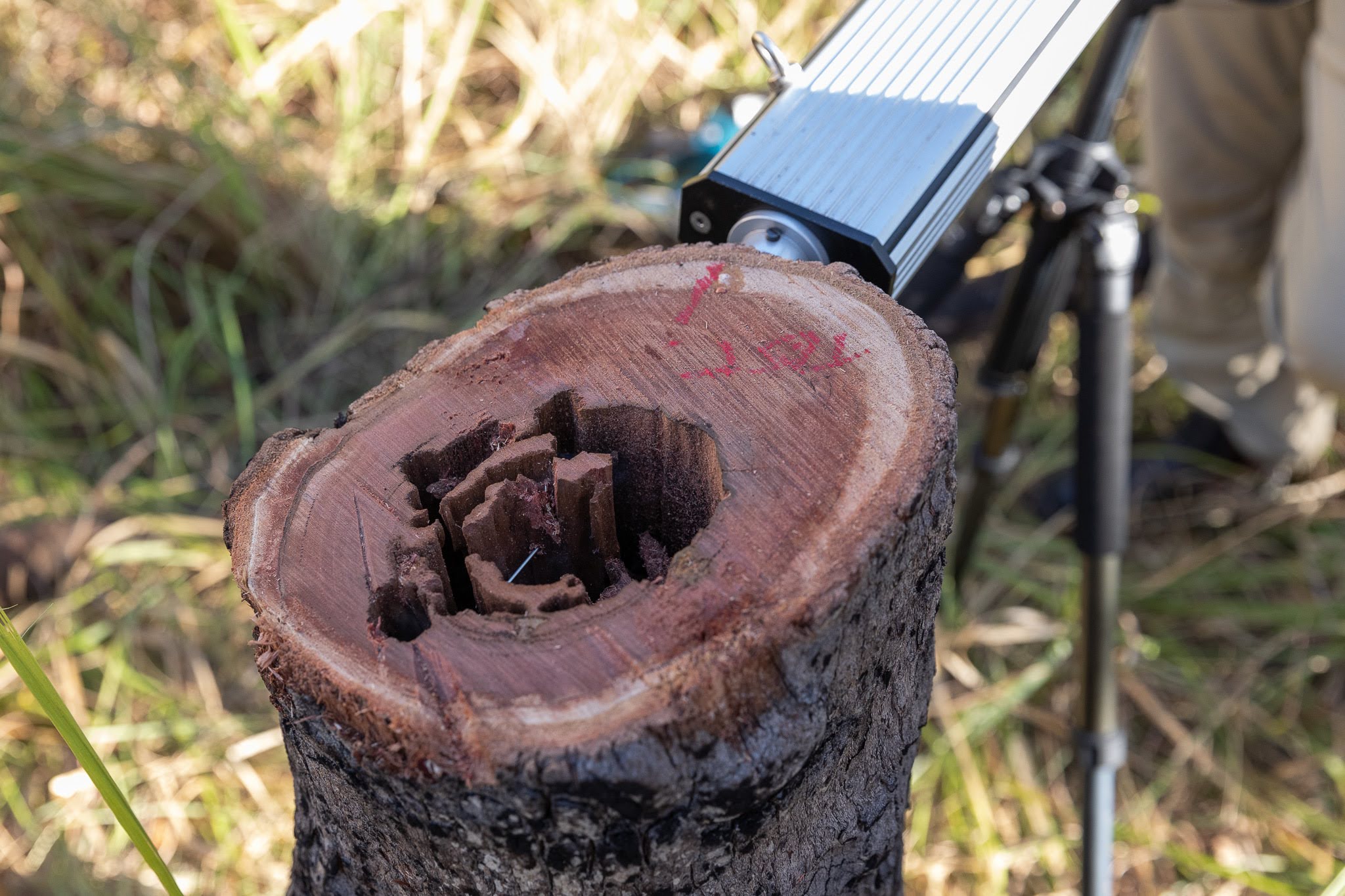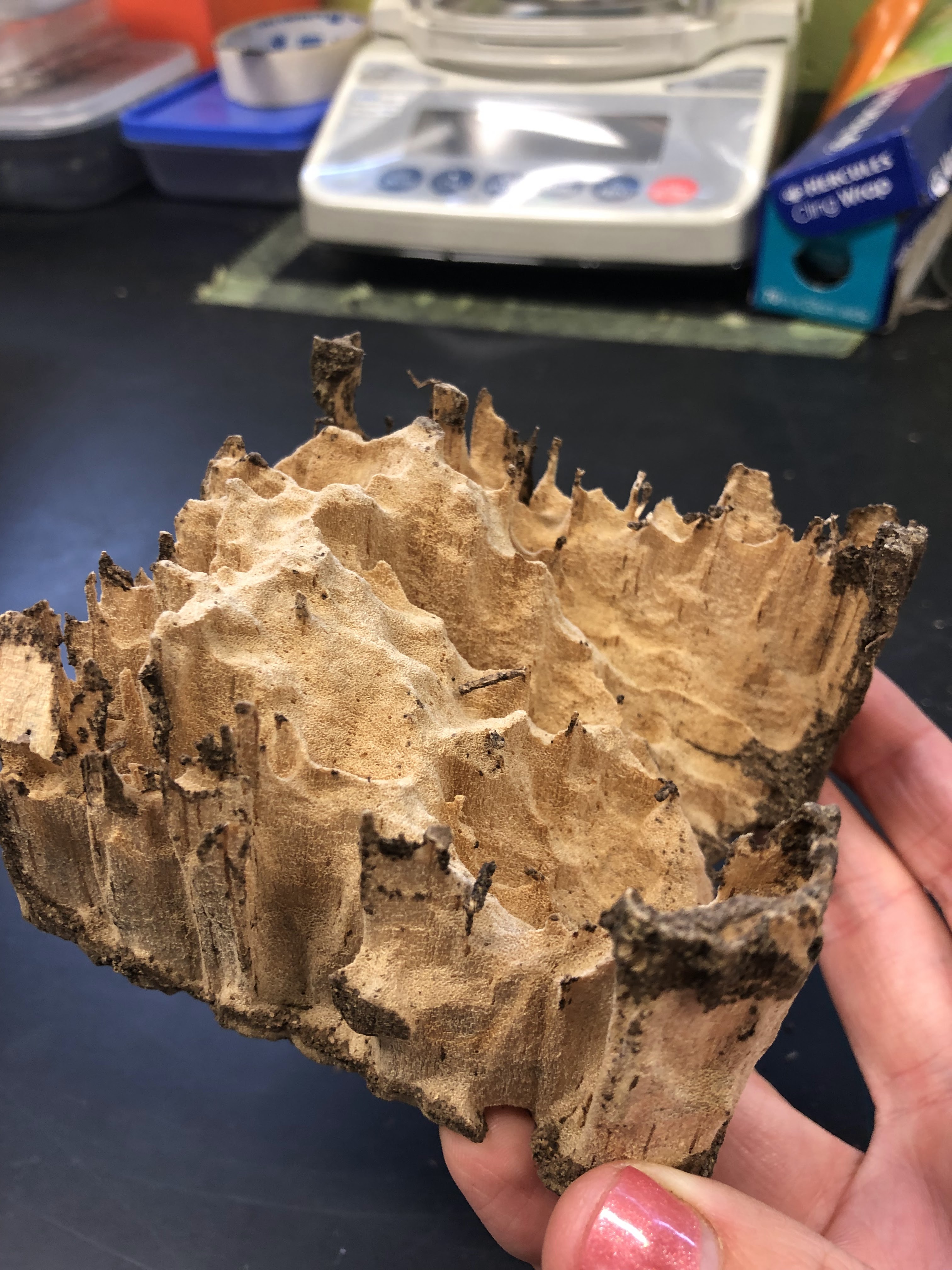Below is a compilation of various published research papers that I have led or collaborated on during my PhD. Also, feel free to check out my Google Scholar profile.
Rotten to the core? Drivers of the vertical profile and accumulation of internal tree stem damage
Functional Ecology 2025, read it here
 The resistograph drill in action.
The resistograph drill in action.
Little is known about the vertical distribution of internal tree stem damage, and in the paper we sought to answer the question: is a single measurement of internal damage representative of the entire tree trunk? Also, I wanted to test if external damage of the tree indicated how much damage was occurring internally. Using a tool called a resistograph drill, we measured the vertical profile of internal stem damage in savanna trees. We found that more wood at the bottom of the tree was damaged, but the ratio of damaged to undamaged wood was maintained through the vertical profile. Overall, the single measurement was sufficient to characterize the damage state of the lower tree stem. Plus, we found that external termite damage predicted more internal damage, and larger, denser trees were more likely to be termite damaged on the outside.
Why are trees hollow? Termites, microbes and tree internal stem damage in a tropical savanna
Functional Ecology 2024, read it here
 A snapshot of our sampling design. Panel b) gives you an idea of what microbial damage looks like, and panel c) and d) depict termite internal stem damage.
A snapshot of our sampling design. Panel b) gives you an idea of what microbial damage looks like, and panel c) and d) depict termite internal stem damage.
In this paper we build off of a previous study to understand how two biotic players, termites and microbes, are involved with the internal stem damage process. We found that internal damage, from both termites and microbes, was greatest at the bottom of the tree, and decreased into the crown. Termites and microbes decayed wood in the same tree but were keeping distance from one another, and some tree species were more internally damaged by termites than by microbes. Overall, in this paper we describe what organisms are decomposing wood within living trees and quantify where they are removing the most carbon, thus revealing shortcomings in current savanna carbon accounting.
Modelling internal stem damage in savanna trees: Error in aboveground biomass with terrestrial laser scanning and allometry
Methods in Ecology and Evolution 2024, read it here
 What it takes to chop down and weigh a tree. Photo courtesy of Indi Gambold
What it takes to chop down and weigh a tree. Photo courtesy of Indi Gambold
In the first published paper from my Ph.D., Dr. Jed Calvert and I led this study to investigate how internal stem damage in living trees impacted differemt methods of aboveground biomass estimation. We used a destructive harvest to validate how terrestrial laser scanning (TLS) and allometric equations estimate tree biomass, and also model how internal damage occurred through the entire stem, base to crown. We found that TLS was a highly accurate tool for estimating tree aboveground biomass, and that greater amounts of internal stem damage led to TLS overpredicting tree biomass. This work offers a new perspective on inaccuracies that internal stem damage may introduce into forest carbon accounting, particularly in savanna ecosystems where termite abundance and activity is high.
The challenge of estimating global termite methane emissions
Global Change Biology 2024, read it here
Termites confronting an intruder. Photo courtesy of Donna Davis
In this new opinion article led by Dr. Stephanie Law, we discuss how there are great uncertainties on the contributions that termites make to the global methane budget. We argue that the current approach for estimating termites’ role in the global methane budget overlooks some key elements of their ecology, and future measurements should incorporate these discrepancies. While much progress has been made towards the goal of quantifying termite methane emissions, there is ample room for improvement, and we use this article to describe a way forward for future data collection and modelling efforts.
Drivers of wood decay in tropical ecosystems: Termites versus microbes along spatial, temporal and experimental precipitation gradients
Functional Ecology 2024, read it here
 A termite-discovered wood block. Photo courtesy of Rebecca Clement
A termite-discovered wood block. Photo courtesy of Rebecca Clement
Building off of Dr. Law’s 2023 paper in Journal of Ecology, Dr. Baptiste Wijas led this study to further characterize wood decomposition across precipitation gradients in space, time and with a simulated drought experiment in tropical Australia. We show that microbial-mediated wood decomposition was slowest in dry sites, in dry seasons, and under simulated drought conditions. When wood was discovered by termites, it decomposed much faster than when blocks went undiscovered. Termite discovery was greatest in dry savanna sites, and was unaffected by seasonality and drought. We conclude that precipitation plays and important role in shaping wood decomposition rates, especially in regards to biotic decomposers, and should be taken into account in carbon cycling models.
Shifts in internal stem damage along a tropical precipitation gradient and implications for forest biomass estimation
New Phytologist 2024, read it here
 Measuring internal stem damage. Photo courtesy of Michaela Fitzgerald
Measuring internal stem damage. Photo courtesy of Michaela Fitzgerald
Internal stem damage occurs when decomposers break down wood within living trees, however little is known about what trees are affected, how much damage occurs, and what implications this has for estimating tree biomass. Dr. Habacuc Flores-Moreno led this study to investigate internal stem damage across a rainfalll gradient in tropical North Queensland, Australia. We show that stem damage was greater in larger, denser trees, and damage increased in dry environments with high termite pressure. As this is one of the first comprehensive studies characterizing the drivers and extent of internal stem damage, we propose that without accounting for damage to wood inside of trees, our understanding of terrestrial carbon storage is likely incomplete.
Wood traits explain microbial but not termite‐driven decay in Australian tropical rainforest and savanna
Journal of Ecology 2023, read it here
Wood blocks deployed for the decay experiemnt. Photo courtesy of Amy Zanne
Understanding wood decomposition is an important element of the terrestrial carbon cycle, yet there is high uncertainty in how wood breaks down in tropical environments and how this is influenced by wood traits and active decomposers. In this study, led by Drs. Stephanie Law and Habacuc Flores-Moreno, we used an exclusion experiment to understand the role of microbes and termites in the wood decay process of native tree species across a rainfall gradient. While we expected termites to greatly increase wood decay rates, we found this to be only true in the rainforest. We showed that wood traits explained a high amount of variation in microbial decay, but not termite decay. Taken together, we show how the drivers of wood decay differ between Australian tropical rainforest and savanna systems.
Assessing the Australian termite diversity anomaly: how habitat and rainfall affect termite assemblages
Frontiers in Ecology and Evolution 2021, read it here
Searching for termites. Photo courtesy of Donna Davis
In this paper, we assembled an international team of researchers from Australia, the UK, and the USA to better understand how termite diversity shifted over a tropical rainfall gradient in North Queensland, Australia. Led by Dr. Rebecca Clement, our study found that termite abundance in mounds and dead wood occupancy was greater at dry savanna sites compared to wet rainforest sites, and termites had greatest activity at dry sites. We observed highest termite species richness and abundance at dry sites, and low species diversity in the rainforest: we deem this the ‘Australian termite diversity anomaly’, and suggest this may be driven by how termites of different feeding groups colonized Australia.